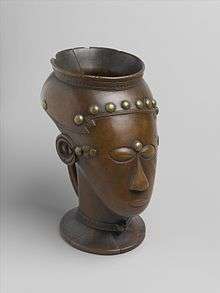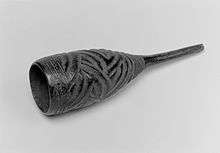Kuba art

Perhaps the best known of the southern savanna kingdoms is that of the Kuba, which developed during the early seventeenth century and reached its peak in the second half of the nineteenth. The historian Jan Vansina divides Kuba history in six phases surrounding a chronology of leaders and seminal events.[1] Nineteen different ethnic groups are included in the kingdom, which still exists and is presided over by the nyim, or king.
Art associated with the Kuba is renowned for its broadly diverse array of media. A great deal of the art was created for the courts of chiefs and kings and was profusely decorated, incorporating cowrie shells and animal skins (especially leopard) as symbols of wealth, prestige and power. Masks are also important to the Kuba. They are used both in the rituals of the court and in the initiation of boys into adulthood, as well as at funerals. The Kuba are also known for the production of beautifully embroidered raffia textiles, made for adornment, woven currency, or as tributary goods for funerals and other seminal occasions.[2] The wealth and power of the elaborate court system allowed the Kuba to develop a class of professional artisans who worked primarily for the courts but also produced objects of high quality for other individuals of high status.[3]
Decorative arts and surface design


Kuba art is celebrated for its decorative arts and surface designs. Personal and decorative artistry is expressed in flatwork – woven cloth or designs on mats and textiles – as well as three-dimensional objects – lidded bowls and boxes, cups, clysters, musical instruments, knives with decorated handles, and baskets.[4] The exterior and interior surfaces of the raffia-walled homes of Kuba elites were also plated with intricate geometric patterning. This proclivity for surface design was shared across most media, including Kuba textiles and body scarification.[4]
Kuba textiles
See full article: Kuba textiles
Kuba headdresses
Headdresses are major symbols of power in traditional Kuba society. They are the symbols of a person’s role in an intricate system of leadership and titleholding, and are usually buried with the owner at their time of death. Headdresses are designed to call attention to the head as the source of divine power, and are worn at dances, funerals, and other major communal ceremonies. Cotton cloth, cowrie shell, raffia fiber, wood, and glass beads are commonly used materials in the creation of various headdresses. The mpaan is one example of a Kuba headdress, although it’s exclusively worn by female titleholders. [5]
Kuba masks
See full article: Kuba masquerade
Among the Kuba, masks are thought to be reflections of nature-spirits (mingesh) that act as intermediaries between the Supreme Being (Nyeem) and the world of mortals. There are more than twenty different types of masks that function within the men's initiation society. Moshambwooy is one of the three most important and represents Woot, the founding hero from whom the Kuba believe themselves to be descended.
Kuba ndop
.jpg)
See full article: Ndop (Kuba)
Kuba kings were sometimes commemorated by 'portraits' that were carved to encapsulate principles of kingship. However, unlike portraiture in European art, these figures, called ndop, were not actual representations of the deceased king but a carving of his spirit, produced after the death of the king. Measuring about 48-55 centimeters in height, ndop are carved of hardwood, which is unusual in African art, and they are in a posture that is equally rare in African sculpture. Each sits crosslegged on a square base from which a small wooden object projects. The figures' identities can be determined according to these emblematic objects.[6]
Kuba drinking vessels
Ornately carved wooden containers were kept by Kuba to store costume accessories and items used for personal care. These included razors, beads, and camwood powder used to coat and beautify the skin. Surface decoration that cover these vessels and boxes are known as nnaam, a Kuba term referring to the tangled vines and creepers that grow in the fertile forests of this region. The replication of a woven basketry artifact in carved wood is characteristic of the playful invention of Kuba personal arts.[7]
At the court, drinking vessels were used to drink and serve palm wine, which Kuba titleholders would distribute in large quantities to their friends and associates in order to display their wealth and generosity.[8][9]
References
- ↑ Vansina, Jan (1960). "Recording the Oral History of the Bakuba – II. Results". The Journal of African History. 1 (2): 261. doi:10.1017/s0021853700001833.
- ↑ Cornet, Joseph (1982). Art Royal Kuba. Milan.
- ↑ Seigmann, William C.; Dumouchelle, contributions by Kevin D. (2009). African art a century at the Brooklyn Museum. Brooklyn, NY: Brooklyn Museum. ISBN 9780872731639. Cite uses deprecated parameter
|coauthors=(help) - 1 2 Binkley, David A; Patricia Darish (2009). Kuba. Milan: 5 Continents Edition.
- ↑ Kreamer, Arnoldin, Christine, Mary Jo (1995). Crowning Achievements: African Arts of Dressing the Head. University of California Los Angeles, Fowler. ISBN 0930741439.
- ↑ Adams, Monni (May 1988). "18th-Century Kuba King Figures". African Arts. 21 (3): 32-38+88. doi:10.2307/3336440.
- ↑ "Vessel: Lidded". Collections. The Metropolitan Museum of Art. Retrieved 10 June 2013.
- ↑ "Vessel: Head". Collections. The Metropolitan Museum of Art. Retrieved 10 June 2013.
- ↑ "Kuba wood cups (part 2) (Zaire)". The Philip Gould Collection. 2016-05-28. Retrieved 2016-06-03.